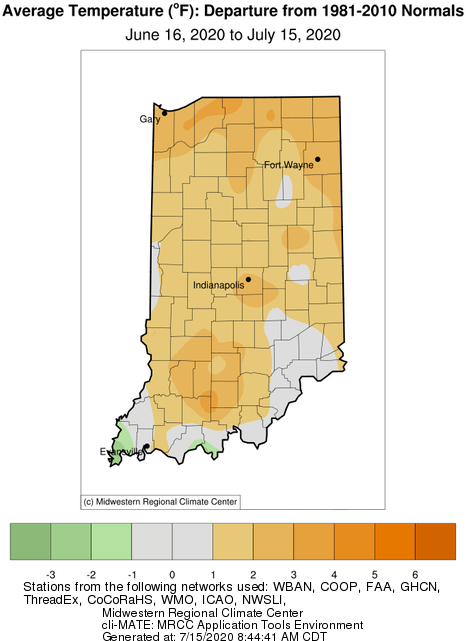
Corn blotch leafminer, Agromyza parvicornis, is a leaf-feeding insect normally considered an “occasional or non-economic” pest.

Corn blotch leafminer, Agromyza parvicornis, is a leaf-feeding insect normally considered an “occasional or non-economic” pest.

Environmental conditions that exist when forages are ready to be harvested influences the amount of hours that it takes to get to a safe baling moisture.

White-tailed deer (Odocoileus virginianus) are among the common mammal pests of field corn in Indiana.

The “notched leaf edge” symptom in corn is a curious genetic leaf “disorder” that appears in certain hybrid families during periods of rapid development.

The past 30 days have been met with warmer than normal temperatures in the northern counties and drier than normal conditions throughout most of the state. This warm and dry environment is conducive to developing drought – particularly with the increased evapotranspiration rates. While climate outlooks are calling for increased confidence of above-normal precipitation throughout the rest of July, these events are likely to remain spotty with inconsistent coverage across the state.

Many plants have poisonous compounds that can cause all kinds of concerns, and even death, if consumed. The interactions that I have had with veterinarians, suggest that the yew is right at or near the top of plants that cause livestock death.

The field crop pathology research program is tracking the distribution of corn and soybean field diseases in Indiana. We are predominantly interested in the following samples (but always keeping an eye out for others):
Corn: tar spot, northern corn leaf blight, and southern corn rust
Soybean: frogeye leaf spot

Recent rains and increased humidity across Indiana have increased the risk for foliar diseases to develop in both corn and soybean. Much of the corn has begun to tassel and soybeans have begun to flower. We are starting to see common diseases in the lower canopy of corn, as we were out scouting this past week. A few diseases that I have seen included gray leaf spot, northern corn leaf blight, common rust, Physoderma brown spot and northern corn leaf spot in corn (Figure 1). Diseases in soybean have been extremely low – I found a few frogeye lesions this past week. Since we are at R1 it is time to scout your soybeans for frogeye leaf spot. Management practices for frogeye are aimed reducing soybean susceptibility and inoculum availability. Infected debris from previous crops is the primary source of inoculum for this disease. Any practice that helps reduced or[Read More…]

Reports of grasshoppers within fields have been received. The pictures and videos included with the emails showed numerous grasshopper nymphs severely defoliating soybean that were planted into a standing cereal rye cover crop. The soybean plants were delayed in growth, as they were shaded by the dying rye. Grasshoppers, as the name suggests, love feeding on a range of grasses but are certainly not limited to this group of plants.

When weed control is delayed in fields, previously unseen insects become nuisance pests for the growing crop. This week, agronomists in central and northeastern Indiana, sent pictures with the “What is this bug?” question. We’ve had similar encounters with the redheaded flea beetle in past years.
© 2024 Purdue University | An equal access/equal opportunity university | Copyright Complaints | Maintained by Pest&Crop newsletter
If you have trouble accessing this page because of a disability, please contact Pest&Crop newsletter at luck@purdue.edu.